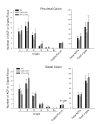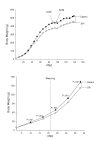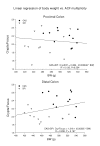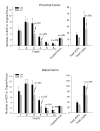Feeding of soy protein isolate to rats during pregnancy and lactation suppresses formation of aberrant crypt foci in their progeny's colons: interaction of diet with fetal alcohol exposure
- PMID: 15488141
- PMCID: PMC526211
- DOI: 10.1186/1477-3163-3-14
Feeding of soy protein isolate to rats during pregnancy and lactation suppresses formation of aberrant crypt foci in their progeny's colons: interaction of diet with fetal alcohol exposure
Abstract
Soy protein isolate (SPI) in the diet may inhibit colon tumorigenesis. We examined azoxymethane (AOM)-induced aberrant crypt foci (ACF) in male rats in relation to lifetime, pre-weaning, or post-weaning dietary exposure to SPI and also within the context of fetal alcohol exposure. Pregnant Sprague Dawley rats were fed AIN-93G diets containing casein (20%, the control diet) or SPI (20%) as the sole protein source starting on gestation day 4 (GD 4). Progeny were weaned on postnatal day (PND) 21 to the same diet as their dams and were fed this diet until termination of the experiment at PND 138. Rats received AOM on PND 89 and 96. Lifetime (GD 4 to PND 138) feeding of SPI led to reduced frequency of ACF with 4 or more crypts in the distal colon. Progeny of dams fed SPI only during pregnancy and lactation or progeny fed SPI only after weaning exhibited similarly reduced frequency of large ACF in distal colon. Number of epithelial cells, in the distal colon, undergoing apoptosis was unaffected by diet. SPI reduced weight gain and adiposity, but these were not correlated with fewer numbers of large ACF. Lifetime SPI exposure similarly inhibited development of large ACF in Sprague Dawley rats whose dams were exposed to ethanol during pregnancy. In summary, feeding of SPI to rat dams during pregnancy and lactation suppresses numbers of large ACF in their progeny, implying a long-term or permanent change elicited by the maternal diet. Moreover, results support the use of ACF as an intermediate endpoint for elucidating effects of SPI and its biochemical constituents in colon cancer prevention in rats.
Figures







Similar articles
-
Genistein, a soya isoflavone, prevents azoxymethane-induced up-regulation of WNT/β-catenin signalling and reduces colon pre-neoplasia in rats.Br J Nutr. 2013 Jan 14;109(1):33-42. doi: 10.1017/S0007114512000876. Epub 2012 Apr 3. Br J Nutr. 2013. PMID: 22716201
-
Fetal programming of colon cancer in adult rats: correlations with altered neonatal growth trajectory, circulating IGF-I and IGF binding proteins, and testosterone.J Endocrinol. 2007 Oct;195(1):79-87. doi: 10.1677/JOE-07-0256. J Endocrinol. 2007. PMID: 17911399
-
Dietary inulin suppresses azoxymethane-induced aberrant crypt foci and colon tumors at the promotion stage in young Fisher 344 rats.J Nutr. 2002 Sep;132(9):2809-13. doi: 10.1093/jn/132.9.2809. J Nutr. 2002. PMID: 12221250
-
Dietary inulin suppresses azoxymethane-induced preneoplastic aberrant crypt foci in mature Fisher 344 rats.J Nutr. 2002 Sep;132(9):2804-8. doi: 10.1093/jn/132.9.2804. J Nutr. 2002. PMID: 12221249
-
Dietary exposure to soy or whey proteins alters colonic global gene expression profiles during rat colon tumorigenesis.Mol Cancer. 2005 Jan 11;4(1):1. doi: 10.1186/1476-4598-4-1. Mol Cancer. 2005. PMID: 15644144 Free PMC article.
Cited by
-
Lack of efficacy of blueberry in nutritional prevention of azoxymethane-initiated cancers of rat small intestine and colon.BMC Gastroenterol. 2009 Sep 16;9:67. doi: 10.1186/1471-230X-9-67. BMC Gastroenterol. 2009. PMID: 19758446 Free PMC article.
-
Maternal Consumption of Low-Isoflavone Soy Protein Isolate Confers the Increased Predisposition to Alcoholic Liver Injury in Adult Rat Offspring.Nutrients. 2018 Mar 10;10(3):332. doi: 10.3390/nu10030332. Nutrients. 2018. PMID: 29534433 Free PMC article.
-
Prospective cohort study of soy food intake and colorectal cancer risk in women.Am J Clin Nutr. 2009 Feb;89(2):577-83. doi: 10.3945/ajcn.2008.26742. Epub 2008 Dec 10. Am J Clin Nutr. 2009. PMID: 19073792 Free PMC article.
References
-
- Jemal A, Murray T, Samuels A, Ghafoor A, Ward E, Thun MJ. Cancer statistics, 2003. CA Cancer J Clin. 2003;53:5–26. - PubMed
-
- Ries LA, Wingo PA, Miller DS, Howe HL, Weir HK, Rosenberg HM, Vernon SW, Cronin K, Edwards BK. The annual report to the nation on the status of cancer, 1973–1997, with a special section on colorectal cancer. Cancer. 2000;88:2398–2424. doi: 10.1002/(SICI)1097-0142(20000515)88:10<2398::AID-CNCR26>3.0.CO;2-I. - DOI - PubMed
-
- Toyomura K, Kono S. Soybeans, Soy Foods, Isoflavones and Risk of Colorectal Cancer: a Review of Experimental and Epidemiological Data. Asian Pac J Cancer Prev. 2002;3:125–132. - PubMed
-
- Bennink MR. Dietary soy reduces colon carcinogenesis in human and rats. Soy and colon cancer. Adv Exp Med Biol. 2001;492:11–17. - PubMed
Grants and funding
LinkOut - more resources
Full Text Sources
Other Literature Sources

